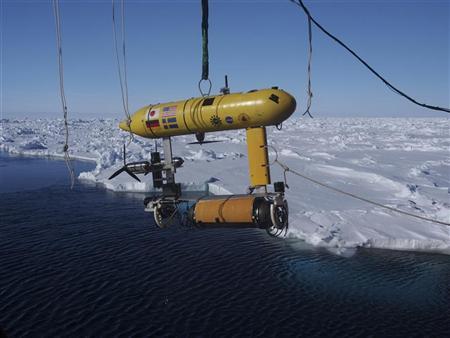Scientists measure sea rise from polar ice melt
Date: 30-Nov-12
Country: UK
Author: Nina Chestney

A free-swimming robot submarine, which is carried aboard the
Australian Antarctic Division's icebreaker, Aurora Australis, is
suspended from a crane in Eastern Antarctica in this September 26,
2012 handout picture made available to Reuters on October 11,
Photo: Australian Antarctic Division/Handout
The melting of the Antarctic and Greenland ice sheets has raised sea levels by 11.1 millimeters since 1992, a fifth of the total rise which threatens low-lying regions around the globe, a new study published on Thursday said.
The results of the study involving 47 researchers from 26 laboratories which was supported by the European Space Agency and the National Aeronautics and Space Administration give the most accurate measurements of ice loss to date, they said in the journal Science.
Two thirds of the ice loss was in Greenland which is losing five times as much ice as in the 1990s, and the remainder was in Antarctica.
Together, the two receding ice sheets are now adding 0.95mm to sea levels a year compared to 0.27mm per year in the 1990s, the study said.
There have been at least 29 studies on ice sheet mass since 1998 which arrive at an average for the melt's contribution to sea level rises of around 1mm a year, the study's leader Andrew Shepherd told reporters.
The researchers used 10 different satellites to measure the shape, speed and weight of the ice sheets from space, as well as ground observations.
Past ice loss assessments typically used just one of those techniques, said Shepherd, a professor at the University of Leeds.
The results come as representatives from nearly 200 countries are in Qatar trying to reach a new global agreement on cutting greenhouse gas emissions, which are widely held responsible for causing global warming.
"The study effectively ends 20 years of uncertainty over the perception of our community. It provides a single climate record for people to use rather than the 40 or 50 which existed before this paper," Shepherd said.
UNSTABLE AREAS PINPOINTED
In 2007 scientists on the Intergovernmental Panel on Climate Change (IPCC) published their fourth report to assess scientific and technical information on climate change and its effects. The next IPCC report is due out next year.
The fourth report estimated a total global sea level rise of 2mm a year from the early 1990s to 2011, while research by the Potsdam Institute for Climate Impact Research this week estimated the rise has been as much as 3.2mm a year over the same period.
"We have pinpointed the areas of ice sheets where people should be concerned," Shepherd said. "There are parts of Antarctic where the ice is not behaving in a normal way. It is unstable and its sea level contribution is rising year-on-year, Greenland even more so," he said.
"That allows us to say to people who build models for future climate projections, 'these are the areas you should concentrate on'," he said, adding that continued monitoring of ice sheets is necessary.
The researchers did not make predictions about how much sea levels were likely to rise this century, saying it was not the aim of the project.
The IPCC has said seas could rise by between 18 and 59 cm this century, not counting the possible acceleration of the melt of the Greenland and Antarctic ice sheets that could add more still water to the oceans. The Potsdam study places that figure even higher at between 50cm and a meter this century.
(Editing by Greg Mahlich)
![]()
© Thomson Reuters 2012 All rights reserved